In 2020, T-Mobile merged with Sprint.
But, executives from both sides were worried.
They had discovered forty-seven different customer databases. Each database contained varied information regarding the same customers.

Revenue losses now totaled USD 2.4 billion.
What followed this loss, was their realization to adopt proper master data management tools to resolve their challenge.
This real-world example shows us my master data management software is important.
Globally, the master data management market size is close to USD 19.9 billion as of 2023, and expected to reach USD 60.7 billion by 2030.
A data integration failure could cost you more than a solution.
Keeping that in mind, the right Master Data Management (MDM) tool is the foundation for providing an authoritative source of truth across all your enterprise systems.
What is Master Data Management (MDM)?
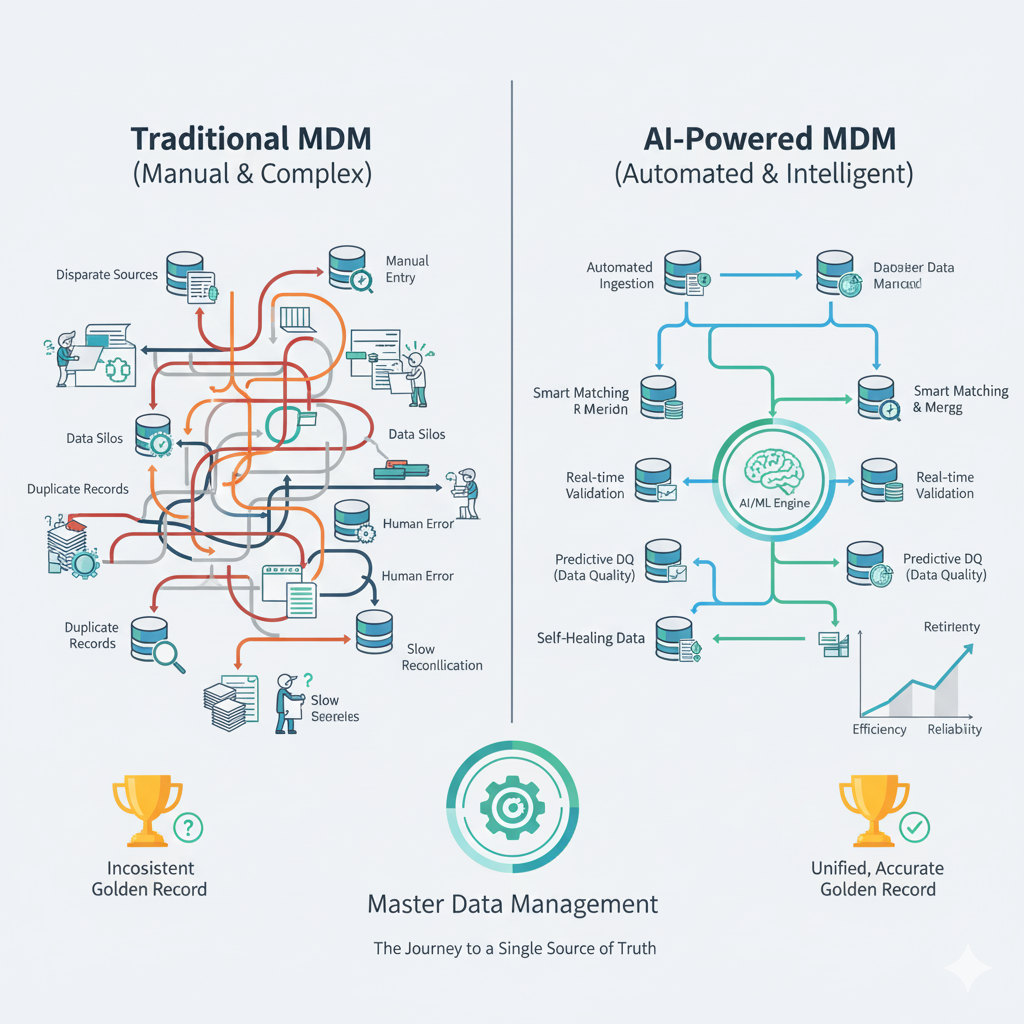
Simply put, MDM creates a singular source of truth.
It consolidates your critical business data across multiple systems.
Consider MDM as your data’s central command center.
They eliminate duplicate records. They standardize formats across platforms.
But most importantly, they ensure data integrity and accuracy throughout your organization.
Why are Master Data Management tools important today?
Firstly, growth.
The growth of master data management software is expected to reach USD 43.38 billion by 2030 at 18.93% CAGR.
Also, according to Gartner, poor data quality costs an organization like yours close to USD 12.9 million annually.
Nearly 87% of data management executives mention data integration as their top priority. Also, companies with master data management software see a revenue growth of 23%.
Core components of Master Data Management solutions
The following infographic shows you three categories (non technical frameworks) with their respective MDM solution benefits.

These components are important to consider when you enter the market for a trusted MDM tool provider.
Master data management tool adoption checklist
Here’s a quick checklist of things to get answers to before you choose the best master data management tool for your organization.
- Problem domain – Identify which data entity of your business requires a data integration solution – Supplier-related, product-related, or customer-based.
- Problem quantification – What is the current bad data costing your business? Examples could be, USD 5 million in shipping errors, 20 hours/weeks spent on data cleanup, or 15% revenue spent on marketing. Here you justify your ROI.
- Core integrations – Identify 3-5 mission-critical systems that need clean master data. Examples here are ERP, your data warehouse, or CRM.
- Deployment model – Do you want a MDM tool that is cloud-based, cloud SaaS, on-premises or hybrid? This filters out most of the vendor tools.
- Data stewards – Do you have an in-house team of data stewards who can be dedicated for implementation? If not, best is to choose an AI-powered automation tool (such as the first one on the list).
Snapshot of the top master data management tools
The following table lists all the top master data management software/tools, to give you a quick snapshot, in case you don’t want to scroll all the way down. They are listed in no particular order.
| Tool | Rating | Pricing Model | Best For | Key Strength | Primary Weakness |
|---|---|---|---|---|---|
| DataManagement.AI | 4.9/5 | Subscription ($2,999–7,999/month) | Autonomous MDM | AI-driven automation | Newer platform |
| Informatica MDM | 4.2/5 | Enterprise ($150K+/year) | Large enterprises | Proven scalability | High complexity |
| SAP MDG | 4.1/5 | User-based ($1,200/user/year) | SAP environments | ERP integration | Vendor lock-in |
| Oracle MDM | 3.9/5 | Processor ($47,500/processor) | Oracle ecosystems | Database integration | High costs |
| IBM InfoSphere | 4.0/5 | Value Unit ($55,000+) | Flexible architecture | Matching algorithms | Complex installation |
| Profisee | 4.7/5 | Subscription ($2,000/month) | Rapid deployment | Fast implementation | Limited references |
| Semarchy xDM | 4.5/5 | Subscription ($3,500/month) | Integrated platform | Model-driven | Limited templates |
| Stibo Systems | 4.3/5 | Custom pricing | Product catalogs | PIM specialization | Domain limitation |
| Talend MDM | 4.1/5 | Open/Enterprise ($1,170/month) | Open-source focus | Integration platform | Limited enterprise |
| Riversand | 4.4/5 | Usage-based | Digital commerce | Cloud-native | Limited presence |
| Magnitude RTIM | 4.1/5 | Custom pricing | Real-time integration | High performance | Limited MDM |
| TIBCO EBX | 4.0/5 | Enterprise licensing | Data governance | Workflow automation | Complex configuration |
| Winshuttle | 3.8/5 | User-based | SAP business users | User-friendly | SAP dependency |
| Ataccama ONE | 4.6/5 | Component-based | Unified platform | AI-powered quality | Newer presence |
| PiLog | 4.7/5 | Quote-based | Business-driven | Adaptive modeling | Limited scalability |
| Syndigo | 4.6/5 | Tiered-based | Reference data | Strong governance | Implementation complexity |
| BackOffice Associates | 4.0/5 | Project/subscription | SAP compliance | Risk management | SAP dependency |
| Tamr | 4.1/5 | Usage-based | ML-driven unification | Automation | Limited adoption |
| Collibra | 4.4/5 | User-based subscription | Data governance | Catalog excellence | Limited MDM focus |
| Denodo | 4.3/5 | CPU-based | Data virtualization | No data movement | Performance considerations |
| Boomi | 4.5/5 | Subscription-based | Standards framework | Industry standards | No software product |
| Precisely Data360 | 4.4/5 | Transaction-based | Customer MDM | Identity resolution | Domain limitation |
| Reltio | 4.2/5 | Data volume-based | Relationship insights | Modern architecture | Platform maturity |
| Snowflake | 4.4/5 | Consumption-based | Cloud data platform | Scalability | Partner-dependent MDM |
| Databricks | 4.3/5 | Usage-based | Custom lakehouse MDM | Unified analytics | No dedicated MDM |
| Microsoft Purview | 4.4/5 | Consumption-based | Azure governance | Microsoft integration | Limited MDM |
| Google Data Catalog | 4.0/5 | Usage-based | GCP metadata | Search capabilities | Basic MDM |
| AWS Glue Catalog | 4.2/5 | Pay-per-use | ETL-integrated catalog | Serverless model | ETL focus |
| Palantir Foundry | 4.0/5 | Enterprise custom | Complex analytics | Advanced integration | High complexity |
| Apache Atlas | 3.8/5 | Free (open-source) | Hadoop governance | No licensing costs | Technical complexity |
| Varada | 4.1/5 | Performance-based | Query acceleration | Performance optimization |
Limited MDM focus |
Complete guide to the best master data management tools
The following master data management software/tools are curated for you.
DataManagement.AI
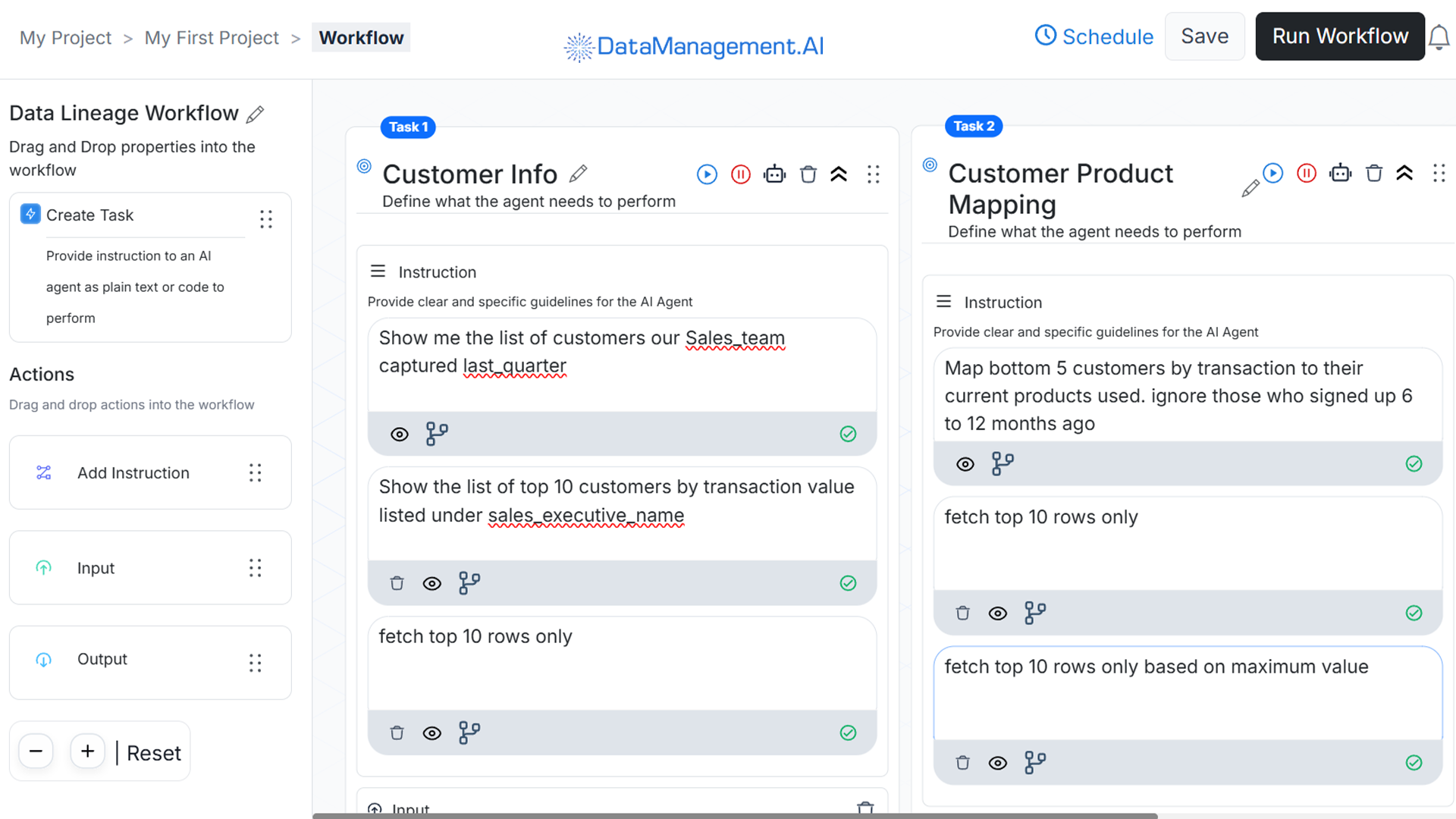
DataManagement.AI revolutionizes your master data management through autonomous AI agents.
The platform provides you with intelligent data quality assessment, along with predictive data governance and automated metadata management.
DataManagment.AI is an AI-native data management platform. The ‘Chain-of-Data’ and ‘Agentic Workflow’ approaches focus on automation, operational efficiency, and speed.
Another ideology that’s unique to DataManagement.ai is Context Cloud.
Imagine data with a story. A full, rich story. It connects all your data points. It adds missing information. It makes data complete. It understands relationships. This creates a ‘chain-of-data.’
This chain enriches data. It reconciles data. It governs data effectively. Your data becomes smart. It gains deep understanding.
This is not just an approach, it’s an intelligent layer. This layer sits over your systems.
It connects them all seamlessly. Agents ingest your data by gathering it from sources. They bring it into one place. Then the magic happens.
Data gets contextualized. It is cleaned and organized. It is prepared for use automatically. It is highly efficient.
AI agents, such as ReconcileAI, CleanseAI, and ProfileAI allow users to query, govern, and analyze master data directly from source systems.
No time-consuming data replication or extraction. DataManagement.AI is built to eliminate all your data bottlenecks, deliver real-time insights, and significantly reduce operation and infrastructure costs.
Segment
Agile/Cloud-native with AI-native focus.
Primary focus
Speed, flexibility, and AI-driven automation via ‘agentic workflow’ for real-time, in-place data governance and quality.
| Core Features |
|
|---|---|
| Key Strengths |
|
| Weaknesses |
|
| Pricing Model |
|
| Best Suited For | Organizations looking for autonomous data management with minimal human intervention. |
| Deployment Strategy | Cloud-native architecture with API-first design enabling rapid deployment across hybrid environments. |
| Integration & Scalability | Offers instant integration and high scalability through in-place data access (no replication required). |
Informatica Master Data Management

Informatica MDM provides you with enterprise master data management cloud solutions. They specifically design solutions for companies, like yours, to take control of their data and put it to work.
Their solutions can be deployed in cloud or on-premise modes. They implement their custom AI engine called CLAIRE.
Segment
Enterprise multi-domain.
Primary focus
Centralized governance across suppliers and other domains. Data quality and data integration capabilities over a cloud-native platform (IDMC).
| Core Features |
|
|---|---|
| Key Strengths |
|
| Weaknesses |
|
| Pricing Model |
|
| Best Suited For | Large enterprises with complex data ecosystems and dedicated IT teams. |
| Deployment Strategy | On-premises, hybrid, and cloud deployment with extensive customization options. |
| Integration & Scalability | Leveraging IDMC platform for native integration with demonstrated ability to manage diverse systems. |
SAP Master Data Governance

SAP Master Data Governance (MDG) is a master data management tool that runs primarily within the SAP S/4HANA or SAP Business Technology Platform (BTP) ecosystem.
Its core strength is centralized governance for your master data – including customers, suppliers, financials – all leveraging the existing SAP model, security configs and business logic.
It relies on integrating data governance directly into core business processes, such as Procure-to-Pay or Order-to-Cash. This ensures data compliance and accuracy before data is used in transactional applications.
Segment
Enterprise multi-domain.
Primary focus
Centralized consolidation and governance. Deeply integrated into SAP S4/4HANA transactional and process ecosystems.
| Core Features |
|
|---|---|
| Key Strengths |
|
| Weaknesses |
|
| Pricing Model |
|
| Best Suited For | SAP-centric organizations require a tight ERP integration.. |
| Deployment Strategy | On-premises or SAP cloud with phased rollout approach. |
| Integration & Scalability | Excellent integration with SAP products. High scalability on the HANA platform. Strong ecosystem support. |
Oracle Master Data Management

Oracle master data management tool is a multi-domain enterprise-level MDM platform. Initially introduced as a standalone MDM platform, it’s now embedded with cloud applications.
It consists of several solutions designed to collect and standardize your Data as a service (DaaS) of the application.
Segment
Enterprise multi-domain.
Primary focus
Deeply integrated with the Oracle application ecosystem, it delivers centralized governance across financial, supplier, and product domains.
| Core Features |
|
|---|---|
| Key Strengths |
|
| Weaknesses |
|
| Pricing Model |
|
| Best Suited For | Oracle-centric enterprises who possess substantial database investments. |
| Deployment Strategy | Gradual domain expansion with database-centric deployment. |
| Integration & Scalability | Good scalability and robustness. Comes with pre-integrated capabilities for Oracle cloud application suite. It uses a modern REST API and a unified data model. |
IBM InfoSphere Master Data Management
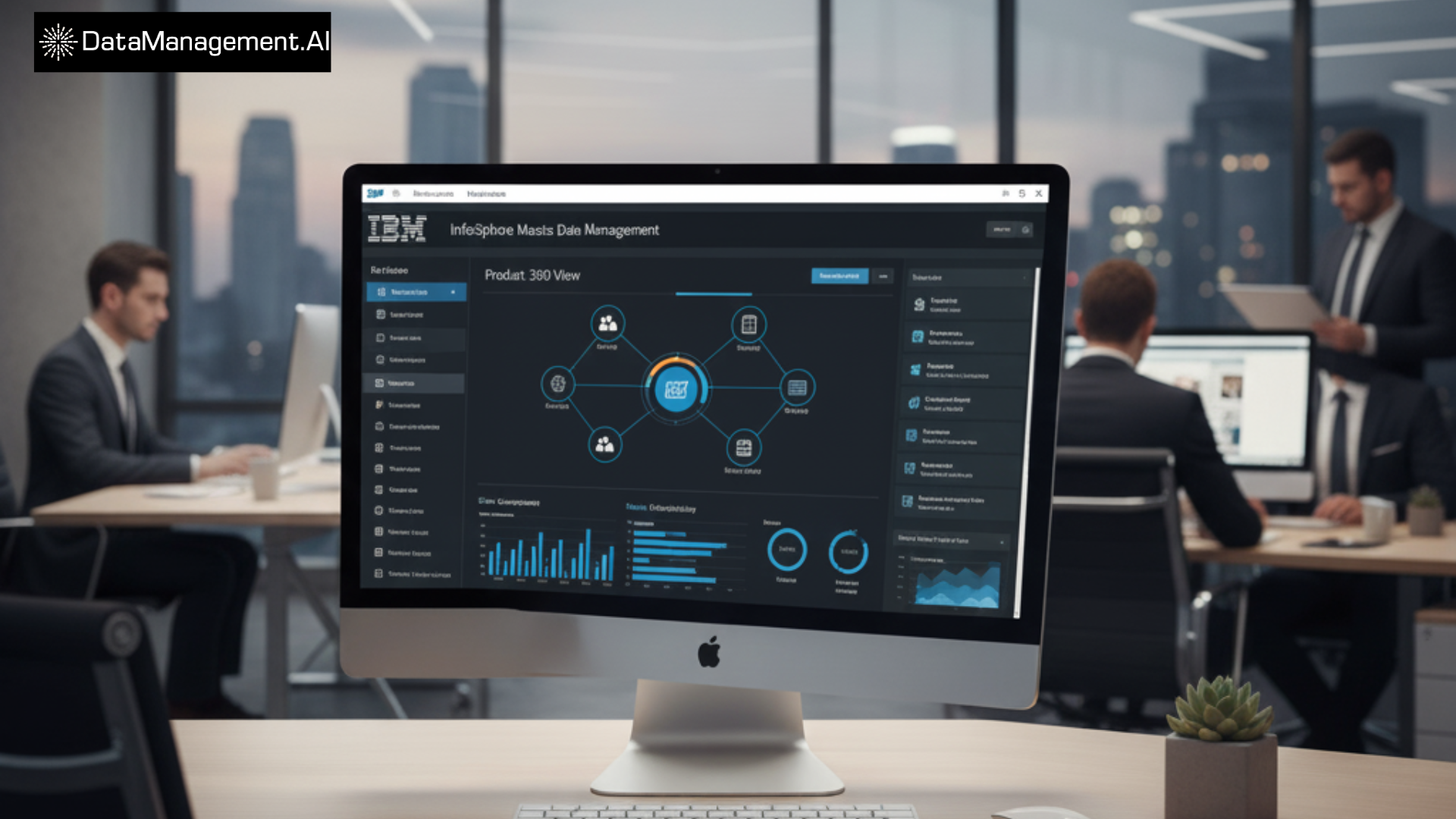
IBM InfoSphere Master Data Management tool includes access to IBM’s data governance and orchestration offerings.
It offers you a configurable framework with capabilities for varied business users as well as data analytics. It offers a flexible deployment style (hybrid, virtual, and physical) with robust data quality tools. It’s architectured for complex hierarchical management. It’s deeply integrated into existing Java EE and IBM environments.
Segment
Enterprise multi-domain.
Primary focus
Compliance at enterprise scale emphasizing on data quality across customers, suppliers, and product-based centralized governance.
| Core Features |
|
|---|---|
| Key Strengths |
|
| Weaknesses |
|
| Pricing Model |
|
| Best Suited For | Large enterprises require flexible MDM architectures. |
| Deployment Strategy | Phased approach with pilot domain validation. |
| Integration & Scalability | High integration score, thanks to, deep integration capabilities within enterprise systems. User reviews confirm its robustness for large data volumes. |
Profisee Master Data Management

Profisee master data management tool employs an ‘Adaptive MDM’ philosophy. It conforms quickly to your existing enterprise systems and governance rules.
It is containerized and deeply integrated into Microsoft Azure ecosystems. It supports deployment on any major cloud (GCP, AWS) or on-premises.
The platform enables organizations to manage suppliers, products, and other domains in a single environment.
Segment
Agile/cloud-native multi-domain.
Primary focus
Cloud-native deployment, speed, and flexibility. Accelerates time-to-value and deeper integration with modern data ecosystems (especially Microsoft Fabric/Azure).
| Core Features |
|
|---|---|
| Key Strengths |
|
| Weaknesses |
|
| Pricing Model |
|
| Best Suited For | Mid-market organizations seeking rapid MDM deployment. |
| Deployment Strategy | Cloud-first with accelerated implementation methodology. |
| Integration & Scalability | Containerized cloud-native architecture enabling infinite horizontal scale. Native integration with Snowflake plus REST API support. |
Semarchy xDM

Semarchy’s master data management tool is based on Google’s Material Design principles. It supports your MDM implementation styles (central, coexistence, and consolidation) across reference data and supplier domains.
Its core strength lies in no-code/low-code application builders. This allows you to deploy custom data management applications and scale across cloud or on-premises environments.
Segment
Agile/cloud-native multi-domain.
Primary focus
Unified platform combining master data management, governance, and data integration. AI-ready data delivered via low-code Intelligent Data Hub approach.
| Core Features |
|
|---|---|
| Key Strengths |
|
| Weaknesses |
|
| Pricing Model |
|
| Best Suited For | Organizations wanting integrated master data management software and data quality tools. |
| Deployment Strategy | Agile implementation with iterative domain delivery. |
| Integration & Scalability | Metadata-driven architecture with native support for Snowflake, major clouds, and on-premises deployment. It scales horizontally through application server clustering. Built-in REST and SQL endpoints. |
Stibo Systems STEP

Stibo master data management tool is a MDM solution that specializes in product information management. It excels in manufacturing and retail.
Its unique solution, STEP, supports multi-domain MDM for assets, employee reference, your location data, and customers.
Segment
Enterprise multi-domain/PIM leader.
Primary focus
Their focus is on building complex data workflows for omnichannel commerce and global commerce.
| Core Features |
|
|---|---|
| Key Strengths |
|
| Weaknesses |
|
| Pricing Model |
|
| Best Suited For | Manufacturers and retailers managing complex product catalogs. |
| Deployment Strategy | Product-centric implementation with channel expansion. |
| Integration & Scalability | Built for enterprise scale with centralized architectures. Successfully deployed for its flexible APIs (REST/GraphQL) and pre-built connectors. |
Talend Master Data Management

Qlik acquired Talend in 2023. Its master data management tool is part of the Qlik Talend Cloud Data Fabric, tightly coupling it with ETL/ELT data integration tools.
It creates a ‘golden record’ across domains – suppliers, customers, and products. It leverages its data integration engine to handle your data from disparate sources. Their custom ‘Talend Trust Score’ provides a measurable assessment of data quality.
Segment
Agile/Integration-focused domain leader.
Primary focus
Focuses on orchestrating and maintaining data health across the entire data lifecycle. Uniquely integrated to ETL/Data quality tools.
| Core Features |
|
|---|---|
| Key Strengths |
|
| Weaknesses |
|
| Pricing Model |
|
| Best Suited For | Organizations preferring open-source foundations. |
| Deployment Strategy | Open-source pilot with enterprise upgrade path. |
| Integration & Scalability | Cloud-agnostic but built for real-time and high volume batch processing. Comes with a library of connectors and components. Good for horizontal scalability for data processing tasks. |
Riversand Master Data Management

Riversand provides a cloud-native master data management tool that focuses on digital commerce and product commerce.
It’s positioned as a master data management software focussed on ‘information journey’ that integrates Digital Asset Management (DAM), Product Information Management (PIM), and content syndication together.
Its key offering lies in its SaaS model and cloud-native scalability. This positioning is highly attractive to CPG, retail, and manufacturing organizations.
Segment
Agile/cloud-native multi-domain leader.
Primary focus
Content syndication for digital commerce. A strong specialization in Product Experience Management (PIM). Also a focus on rapid time-to-value via cloud-native SaaS model.
| Core Features |
|
|---|---|
| Key Strengths |
|
| Weaknesses |
|
| Pricing Model |
|
| Best Suited For | Digital-first organizations requiring modern architecture. |
| Deployment Strategy | Cloud-native with API-driven integration. |
| Integration & Scalability | Pure play cloud-native SaaS solution built on a big data stack for massive variety, velocity, and scale. App Marketplace and SDK for custom extensions and integrations. |
The lack of standardization at GlaxoSmithKline
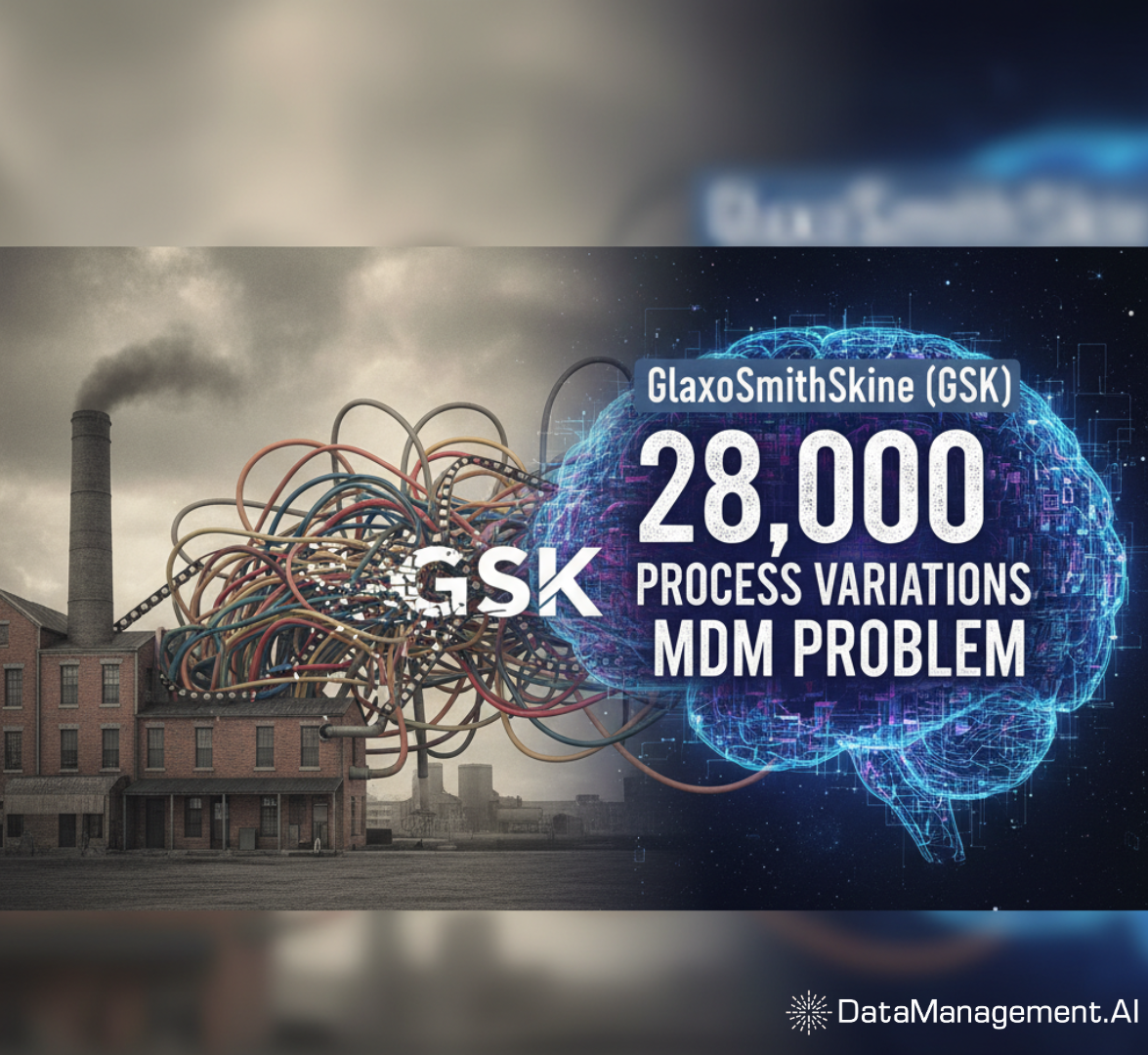
Not implementing a MDM solution can have drawbacks.
GlaxoSmithKline found that the hard way.
Headquartered in the UK, with USD 34 billion in sales around 2020, the company wasn’t a slouch in adopting third-party software to run their business.
They implemented SAP ECC globally starting in 2010. They moved 1,00,000 users and 190 business entities onto a single instance.
GSK used a process-mining tool, Celonis, to discover around 28,000 variations for the process of running a sales order.
Despite having an ERP system, there was massive process fragmentation.
- Not having a MDM solution led to problems, such as,
- Lack of data standardisation – No MDM controls means users created duplicate transactions.
- No centralized data governance – Each region and business unit created its own process variation
- Poor visibility – GSK had lots of anecdotal discussions with users but very little visibility on processes
GSK is one example. There’s many more. If you don’t want to feel like scrolling below to see the rest of the tools, simply click on the blue button below and schedule a quick demo with our MDM experts.
Magnitude Master Data Management
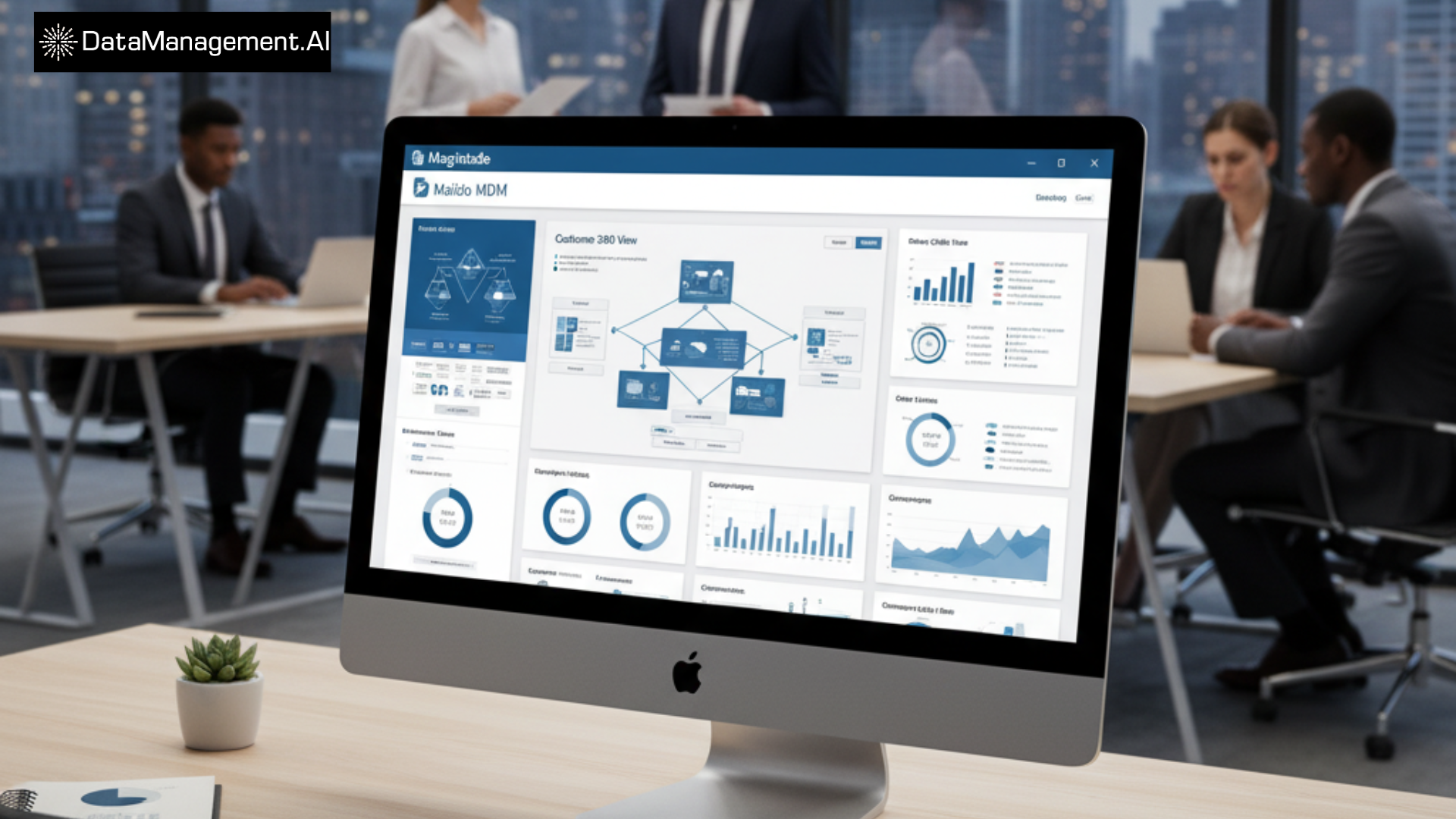
Magnitude’s master data management tool is an enterprise-grade platform for deep domain agnostic data modeling.
Finance and manufacturing-led organizations that need a tightly governed and centralized management for reference data adopt Magnitude MDM.
It excels at establishing a centralized master data authoring system, enforcing a sophisticated and policy-driven workflow process.
Its architecture is engineered to deliver you with a single, trustworthy view on information that’s distributed to analytical systems in real-time.
Segment
Enterprise multi-domain leader.
Primary focus
Policy-driven and centralized governance which is domain-agnostic. It focuses on complex organizational compliance and streamlined global reporting.
| Core Features |
|
|---|---|
| Key Strengths |
|
| Weaknesses |
|
| Pricing Model |
|
| Best Suited For | Organizations that prioritize real-time data integration. |
| Deployment Strategy | Integration-first with gradual MDM expansion. |
| Integration & Scalability | Proven enterprise-grade scalability suitable for global deployments. They also offer universal access and policy-driven APIs that focus on deep integration with ERP systems. |
Tibco EBX Master Data Management

Tibco EBX positions itself as an ‘all-in-one’ master data management tool. It claims to manage all enterprise data assets, including reference, master and metadata.
It allows you to define data models that generate fully configurable data management applications. It provides a hub for robust features towards version control, collaborative data stewardship, and hierarchy management.
Segment
Enterprise multi-domain leader.
Primary focus
Unified, governance, and flexible modeling of all data assets within a single platform. It focuses on business-user adoption, agility, and process-driven governance.
| Core Features |
|
|---|---|
| Key Strengths |
|
| Weaknesses |
|
| Pricing Model |
|
| Best Suited For | Organizations requiring comprehensive data governance. |
| Deployment Strategy | Governance-first with domain specific rollout. |
| Integration & Scalability | Proven enterprise-grade scalability and deep integration capabilities, specifically within the TIBCO Connected Intelligence platform. |
Winshuttle Master Data Management
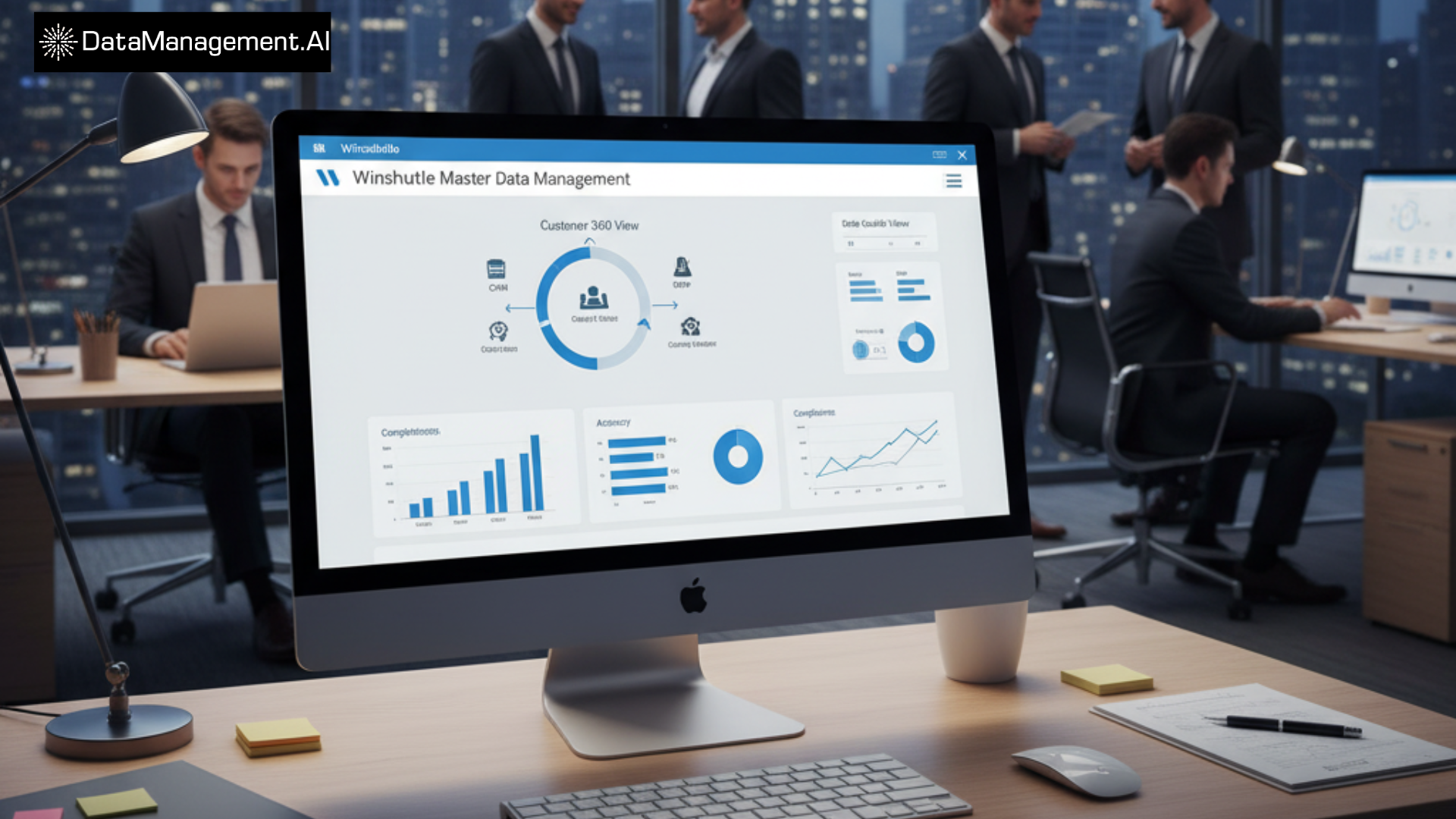
Winshuttle master data management tool is SAP-focussed. Its emphasis is on the ease of use for you. This tool is now part of the Precisely suite.
It’s a solution primarily focussed on streamlining SAP master data processes. It simplifies data validation, creation, and maintenance.
It empowers business users to manage data with user-friendly interfaces instead of relying solely on IT.
Segment
Enterprise multi-domain leader (PIM/E-commerce focus).
Primary focus
Digital Asset Management (DAM) and unified multi-domain governance centered on Product Information Management (PIM).
Also, focused on SAP specialized capabilities for SAP data automation, driving cross-domain intelligence for digital commerce experiences.
| Core Features |
|
|---|---|
| Key Strengths |
|
| Weaknesses |
|
| Pricing Model |
|
| Best Suited For | SAP organizations that need business user access. |
| Deployment Strategy | SAP-centric with user adoption focus. |
| Integration & Scalability | Enterprise-grade scalability that’s built on a modern SOA/micro-services architecture. Plus, a particularly deep integration and automation tools for SAP ERP environments. |
Ataccama ONE Master Data Management

Ataccama ONE is a collaborative data curation master data management tool. Its solution includes data profiling and catalog, data quality, and data governance.
Its master data management software supports multiple domains, hierarchy management, reference data management, and more.
Segment
Enterprise multi-domain leader.
Primary focus
Unified platform for automated MDM, data governance, and DQ across hybrid and cloud environments.
| Core Features |
|
|---|---|
| Key Strengths |
|
| Weaknesses |
|
| Pricing Model |
|
| Best Suited For | Organizations seeking unified data management. |
| Deployment Strategy | Platform-centric with component activation. |
| Integration & Scalability | Unified code base for all for all functions. Native cloud-enabled architecture. High automation rates for all matching workflows and data quality using AI-driven agents. |
PiLog Master Data Management

PiLog’s master data management tool is a multi-domain platform that specializes in standardization of technical data and governance.
It distinguishes itself in adherence to global standards such as ISO 8000. The platform incorporates Generative AI and Conversational AI capabilities.
Segment
Enterprise multi-domain leader (Strong multi-domain support with heavy industry focus).
Primary focus
Centralized governance across Asset and Vendor domains, deep ERP integration (SAP), and Material (MRO).
| Core Features |
|
|---|---|
| Key Strengths |
|
| Weaknesses |
|
| Pricing Model |
|
| Best Suited For | Asset-intensive organizations in energy, utilities, and mining sectors, that require standardized governance over those running SAP. |
| Deployment Strategy | On-premise, cloud, and hybrid models (deployed for on-premise ERP environments). |
| Integration & Scalability | Good for horizontal scalability for data processing tasks. It uses a modern REST API and a unified data model.. |
Syndigo Master Data Management

Syndigo’s master data management tool is part of their broader Product Experience Management (PXM) Cloud suite. It focussed on orchestrating your data across the commercial enterprise.
Its core strength lies in unifying Product Information Management (PIM) and multi-domain MDM into a cohesive system designed to enable and accelerate time-to-market commerce.
Segment
Enterprise multi-domain leader (Strong PIM/PXM focus).
Primary focus
Content syndication, prioritizing PIM, along with unified data delivery across channels.
| Core Features |
|
|---|---|
| Key Strengths |
|
| Weaknesses |
|
| Pricing Model |
|
| Best Suited For | Large brands that focus on digital and e-commerce growth. Streamlining the delivery of rich product content (PXM) across a vast network of trading partners. |
| Deployment Strategy | Cloud/SaaS based that’s built on a modern, cloud-native architecture. |
| Integration & Scalability | User-reported sentiments highlight robust scalability on its modern platform and ease of deployment. |
BackOffice Associates Master Data Management

The BackOffice Associates master data management tool is part of the Syniti Knowledge Platform (SKP). It’s a comprehensive, cloud-native enterprise data management solution.
The tool establishes a singular, trusted view of master data for your product, suppliers, and customer information. It integrates core cap[abilities such as, data governance, data quality, data migration, and data cataloging.
The Syntiti tool suite is designed to accelerate large-scale digital transformation and data migration projects.
Segment
Enterprise multi-domain leader.
Primary focus
Data quality, cleansing, and MDM solutions that rely heavily on ERP environments (mostly SAP) and data migration projects.
| Core Features |
|
|---|---|
| Key Strengths |
|
| Weaknesses |
|
| Pricing Model |
|
| Best Suited For | SAP organizations who require compliance automation. |
| Deployment Strategy | Compliance-driven with process automation. |
| Integration & Scalability | Specialized tools for high-volume ETL/migration for SAP landscapes. Good scalability for accelerating complex data migration and quality remediation projects (SAP S/4HANA transitions). |
Tamr Master Data Management

Tamr master data management tool is an AI-native MDM platform. It specializes in transforming your large, chaotic data into unified ‘golden records’.
Its core reliance is on machine learning and human-guided AI to automate manual and rules-based processes of data mastering.
The platform connects to numerous disparate data sources, then uses machine learning to suggest schema mappings. Tamr is designed for enterprises with large and complex data volumes. They are adopted across domains, such as Supplier Onboarding, Customer 360, and Healthcare.
Segment
Agile/Cloud-native platform.
Primary focus
Automated, ML-driven entity resolution. They do data mastering for large, disparate, and messy data sets across multiple domains.
| Core Features |
|
|---|---|
| Key Strengths |
|
| Weaknesses |
|
| Pricing Model |
|
| Best Suited For | Organizations with complex data unification needs. |
| Deployment Strategy | ML-driven with iterative improvement. |
| Integration & Scalability | Purpose-built for large-scale operations. Schema-on-read ingestion and mastering in data lake/cloud environments. Quick time-to-value for mastering complex domains, such as clinical data due to automation. |
Collibra Master Data Management

Colibra’s master data management tool is deeply integrated into a broader data catalog. Add to this is a data governance framework.
Unlike other traditional MDM tools that focus solely on data cleansing and consolidation, Collibra’s master data management software emphasizes on contextualization and governance of master data.
Its flexible operating model and collaborative workflow defines data ownership, policies, and quality standards for products and customer entities. By combining MDM with data lineage, quality, and privacy features, Collibra ensures the resulting ‘golden record’ is accurate and fully compliant by you.
Segment
PIM/CDI-focussed.
Primary focus
Data cataloging, data governance, and data lineage tracing. It provides content and metadata intelligence across your enterprise.
| Core Features |
|
|---|---|
| Key Strengths |
|
| Weaknesses |
|
| Pricing Model |
|
| Best Suited For | Organizations prioritizing data catalog and governance. |
| Deployment Strategy | Governance-first with MDM integration. |
| Integration & Scalability | API-first design that’s scalable to scan thousands of systems. It’s also vendor-neutral. Rapid deployment of enterprise-wide data catalog and governance frameworks. |
Target Corps’ failed expansion
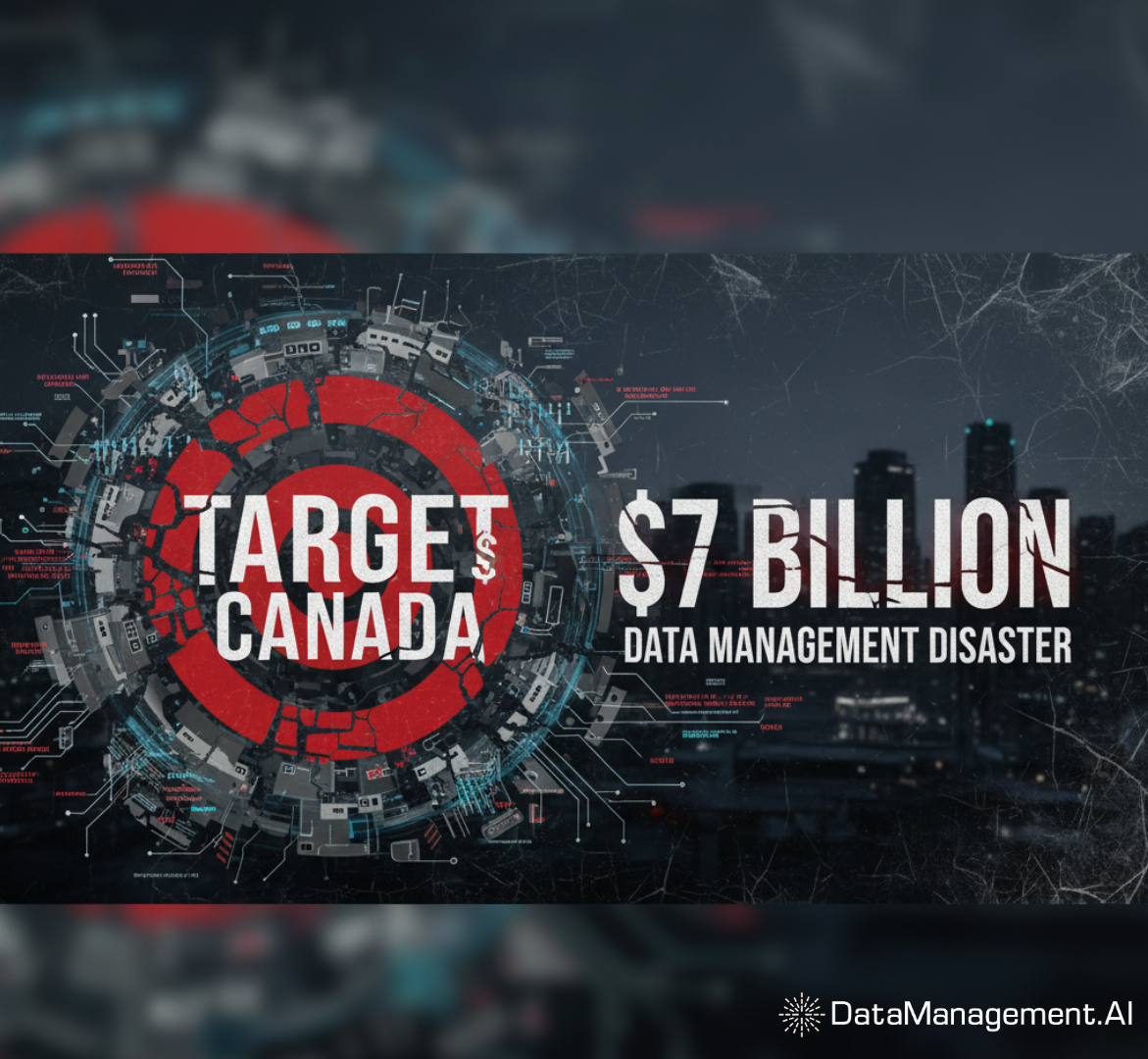
Let’s look at another example of how not implementing a MDM solution leads to failure.
Target’s 113 stores’ expansion lasted just 2 years.
Target Canada’s SAP supply chain management system for the 113 stores acquired were launched in a poor manner. It was improperly configured.
The lack of proper master data management software led to operational failures.
- No data validation of processes – The company lacked MDM tools to cleanse and validate data before going live.
- System integration failure – The Manhattan warehouse software and SAP struggled to communicate properly.
- Vendor communication breakdown – Target and the vendors weren’t on the same page – with shipping dates being incorrectly tagged.
The result was USD 7 billion in losses related to the expansion. 17,600 employees lost their jobs. A total exit from Canada. Damage to reputation.
If you don’t want to feel like scrolling below to see the rest of the tools, simply click on the blue button below and schedule a quick demo with our MDM experts.
Denodo Master Data Management

Denodo’s master data management tool provides you with a logical data layer without requiring any physical data movement or replication.
It functions as a virtual master data management software, which unifies your master data from varied sources.
The platform creates a ‘golden record’ view by querying the source systems on demand. Denodo’s semantic layer then ensures a consistent business meaning across disparate sources.
Segment
Agile/cloud-native focussed platform.
Primary focus
Logical data fabric that enables real-time data access and integration from different sources, all without any physical consolidation.
| Core Features |
|
|---|---|
| Key Strengths |
|
| Weaknesses |
|
| Pricing Model |
|
| Best Suited For | Organizations needing agile data access without movement. |
| Deployment Strategy | Virtualization-first with logical integration. |
| Integration & Scalability | Excellent connectivity options with strong performance for virtualizing complex data views in real-time. Scalability is good as it reduces the need for ETL/physical data movement for analytics use cases. |
Boomi Master Data Management

Boomi Master Data Hub (MDH) is a master data management tool that’s part of Boomi Enterprise Platform. It’s a cloud-native, unified solution for data management, data integration, and automation.
MDH moves beyond centralized MDM systems by delivering a lighter, cloud-based architecture. It establishes ‘golden records’ – a singular and accurate version of your critical data.
It synchronizes this data across integrated applications, accelerating business processes, and ensuring data readiness.
Segment
MDM delivered via an Integration Platform as a Service (iPaaS) ecosystem.
Primary focus
Create, govern, and synchronize a trusted version of data across hybrid (on-premises and cloud) IT landscapes.
| Core Features |
|
|---|---|
| Key Strengths |
|
| Weaknesses |
|
| Pricing Model |
|
| Best Suited For | Mid-to-large enterprises seeking an agile, multi-domain MDM solution. |
| Deployment Strategy | Cloud-native with decentralized connectors managed by Atoms (runtime engines). |
| Integration & Scalability | Natively built on Boomi’s Integration Platform as a Service (iPaas). Scalable performance and access to a vast connector library. |
Precisely Data360
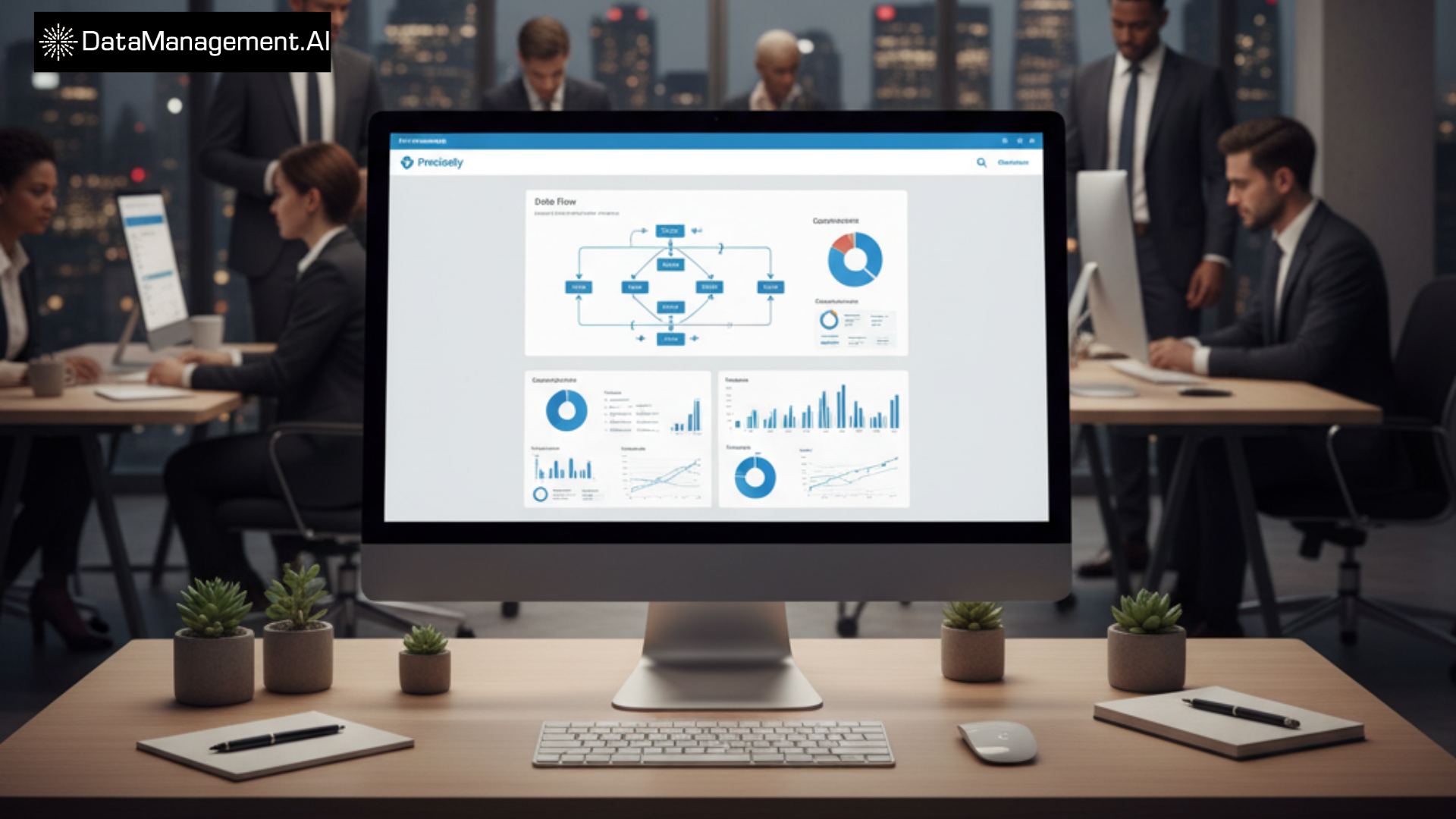
Precisely Data360 is a master data management tool that primarily delivers solutions through its Precisely EnterWorks suite.
Data360 Govern, a component of the suite, delivers essential quality layers, catalog, and data governance. The platform gives business users a single, searchable inventory.
It facilitates the creation of a ‘golden record’ by ensuring high data quality through automated validation. Precisely aims to ensure all master data – for supplier, customer, and product, are understood and consistently applied across the enterprise.
Segment
PIM/CDI focussed (specifically for Data Quality).
Primary focus
Comprehensive data quality, data governance, and data observability that focuses on monitoring and improving data trust across the data pipeline.
| Core Features |
|
|---|---|
| Key Strengths |
|
| Weaknesses |
|
| Pricing Model |
|
| Best Suited For | Organizations focusing on customer master data. |
| Deployment Strategy | Customer-centric with identity resolution. |
| Integration & Scalability | Cloud-native architecture designed for high-volume data profiling and continuous quality monitoring. |
Reltio Connected Data Platform

Reltio’s master data management tool is a cloud-native SaaS solution that allows you to manage and unify core data identities.
A key differentiator is its multi-model data store, which also includes a Connected Graph technology. This discovers and visualizes complex relationships between your data entities and their interactions.
The platform is engineered for real-time operations and scalability, handling numerous profiles and delivering data via an API-first approach. Reltio’s Velocity Packs provide pre-built, industry-specific models to accelerate deployment and deliver value.
Segment
Agile/cloud-native platform.
Primary focus
Real-time, cloud-native multi-domain MDM that leverages a graph database to manage complex relationships (Customer 360 focus).
| Core Features |
|
|---|---|
| Key Strengths |
|
| Weaknesses |
|
| Pricing Model |
|
| Best Suited For | Organizations requiring a relationship-centric MDM. |
| Deployment Strategy | Cloud-native with relationship analytics. |
| Integration & Scalability | True cloud-native multi-tenant SaaS architecture with excellent real-time API capabilities. |
Snowflake Data Cloud

The Snowflake Data Cloud master data management tool is a scalable platform that’s integral to your MDM strategy. It serves as a central data repository for high-quality and unified data – acting like a singular source of truth.
Snowflake’s architecture separates storage and compute, enabling MDM solutions to perform your data matching, data quality, and deduplication processes with scalability.
Other MDM tools such as those from Semarchy, Profisee, and Informatica, offer solutions that integrate tightly or run natively within the Snowflake Data Cloud. MDM logic and stewardship workflows execute directly within Snowflake, eliminating the need to constantly move data for governance.
Segment
Agile/cloud-native platform (data platform).
Primary focus
Cloud data warehousing, data sharing, and data lake capabilities. It serves as a central data hub for AI/ML and data analytics.
| Core Features |
|
|---|---|
| Key Strengths |
|
| Weaknesses |
|
| Pricing Model |
|
| Best Suited For | Organizations with cloud-first data strategy. |
| Deployment Strategy | Platform-centric with MDM partner integration. |
| Integration & Scalability | Infinitely scalable with a pay-as-you-go model which is apt for ecosystem integration. Close to zero administration overhead. |
Databricks Lakehouse Platform

The Databricks Lakehouse master data management tool is a robust platform. It can build and operationalize MDM solutions to leverage unified architecture. It integrates the governance and reliability of your data warehouse.
The platform is built on Delta Lake. This allows it to provide features such as ACID transactions and schema enforcement. Unity Catalog is central to governance – allowing it to offer a metadata layer, data lineage, and fine-grained access control.
Databricks’ integrated machine learning tools help leverage advanced entity resolution and deduplication.
Segment
Agile/cloud-native platform (data platform).
Primary focus
Unified master data management software that blends data lake and data warehousing concepts for BI and AI/ML workloads.
| Core Features |
|
|---|---|
| Key Strengths |
|
| Weaknesses |
|
| Pricing Model |
|
| Best Suited For | Organizations building custom MDM on lakehouses. |
| Deployment Strategy | Platform-based with custom MDM development. |
| Integration & Scalability | Massively scalable using Apache Spark engine. It can be optimized for semi-structured or unstructured data volumes. |
Microsoft Purview Data Map

The Microsoft Purview Data Map is a cloud-native engine that powers the Microsoft Purview unified data governance solution. It scans and catalogs metadata from data sources across your organization’s multi-cloud environments.
Data Map uses built-in classifiers and Azure API to detect and label sensitive data. The Data Map is not a standalone MDM tool, but acts as a central metadata repository for your data governance.
It also integrates successfully with partner MDM solutions, such as Semarchy and Profisee to unify data governance efforts.
Segment
PIM/CDI focussed (catalog/governance).
Primary focus
Unified risk management, data governance, and data catalog services that are deeply integrated with Microsoft Azure and 365 ecosystems.
| Core Features |
|
|---|---|
| Key Strengths |
|
| Weaknesses |
|
| Pricing Model |
|
| Best Suited For | Microsoft-centric organizations requiring governance. |
| Deployment Strategy | Governance-first with Azure integration. |
| Integration & Scalability | Deep native scanning and lineage tracking for data that resides within the Azure ecosystem. Simplifies risk management and compliance by delivering a centralized lineage view of sensitive data assets in Azure. |
Google Cloud Data Catalog

Google Cloud Data Catalog is a master data management tool that fully manages your metadata and data discovery management. Its core function is to automatically scan, index, and organize metadata from data assets across the Google Cloud environment.
Unlike a traditional MDM tool, Data Catalog does not perform direct data cleansing, de-duplication, record matching, or ‘golden record’ creation. It provides a business glossary to define consistent policies and technology that are prerequisites for MDM programs.
When combined with Dataplex, it supports automated data quality features to validate and profile data against defined rules.
Segment
PIM/CDI focussed (catalog).
Primary focus
Fully managed, scalable metadata discovery service for all data assets across the Google Cloud (Pub/Sub, Cloud storage, Bigquery etc.).
| Core Features |
|
|---|---|
| Key Strengths |
|
| Weaknesses |
|
| Pricing Model |
|
| Best Suited For | Google Cloud organizations requiring metadata management. |
| Deployment Strategy | Cloud-native with metadata focus. |
| Integration & Scalability | Native, seamless integration with all Google Cloud data services. It’s also a serverless architecture. Accelerated data search and discovery for data scientists and analysts that operate primarily within the GCP environment. |
Amazon Web Services Data Catalog
The AWS Glue Data Catalog is a centralized master data management tool that operates as a Hive-compatible metastore. The Catalog stores schemas, table definitions, and data locations for data residing in data lakes, databases, and data warehouses.
It allows services like Amazon Redshift Spectrum, Amazon Athena, and Amazon EMR to query data without needing to manage the underlying infrastructure. The Data Catalog acts like a foundation for MDM capabilities to integrate broader AWS Glue ETL features.
Features such as automated schema discovery via schema versioning and Crawlers, help maintain consistent metadata.
Segment
PIM/CDI focussed (catalog).
Primary focus
Managed metadata repository for tracking and defining data assets across various AWS services (primarily Redshift/Athena/AWS Glue).
| Core Features |
|
|---|---|
| Key Strengths |
|
| Weaknesses |
|
| Pricing Model |
|
| Best Suited For | AWS organizations with ETL-centric needs. |
| Deployment Strategy | ETL-integrated with catalog automation. |
| Integration & Scalability | Core foundational service for the entire AWS ETL and data lake stack. Provides the essential metadata backbone for running cost-effective, large-scale serverless ETL jobs on AWS. |
Palantir Foundry

Palantir Foundry is a master data management tool that unifies complex and disparate data sets from various sources. The platform’s Ontology layer is crucial for MDM. It defines real-world business objects and the relationships between them.
Foundry enforces strong data quality, governance, lineage controls, which are foundational for maintaining trusted master data.
By integrating this master data with operational applications, Foundry allows you to make data-driven decisions based on a shared semantic model.
Segment
Agile/cloud-native platform.
Primary focus
Enterprise-grade operational data platform to integrate, analyze, and manage complex data for operational decisions.
| Core Features |
|
|---|---|
| Key Strengths |
|
| Weaknesses |
|
| Pricing Model |
|
| Best Suited For | Organizations with complex analytical requirements. |
| Deployment Strategy | Analytics-driven with an integration platform. |
| Integration & Scalability | Exceptional data security, fusion, and scalability capabilities for highly regulated industries and government. High velocity of data contextualization and integration for complex use cases in intelligence, defence, and manufacturing. |
Apache Atlas

Apache Atlas is an open-source metadata management and data governance framework. Its primary function is to provide you with core foundational services, particularly the Hadoop ecosystem.
Atlas allows you to build a comprehensive data catalog of data assets by storing and collecting metadata using Entity and Type systems. Atlas also supports the definition of classifications and taxonomies. This allows entities to be tagged with terms like “PII (Personally Identifiable Information)”.
Segment
PMI/CDI focussed platform (open source).
Primary focus
Open-sourced data governance and metadata framework. Focus is the integrated Hadoop ecosystem (Cloudera/Hortonworks) for classification and lineage.
| Core Features |
|
|---|---|
| Key Strengths |
|
| Weaknesses |
|
| Pricing Model |
|
| Best Suited For | Organizations with Hadoop ecosystem and technical resources. |
| Deployment Strategy | Open-source with community support. |
| Integration & Scalability | Scalability tied to the underlying Hadoop cluster. It requires internal engineering resources for maintenance. Zero licensing costs. API-driven metadata management and lineage for big data environments. |
Varada Data Platform

Varada Data Platform is a data lake analytics accelerator and query engine. Its mission is to enable you with ad-hoc and extremely fast queries directly onto cloud data lakes.
The platform’s flagship feature is its patented indexing technology. It autonomously creates the optimal index for each data set. This is crucial for business intelligence, analytics, and data science use cases.
Segment
Agile/cloud-native platform.
Primary focus
SQL query acceleration engine that uses patented indexing technology. The focus is to also speed up analytics on massive datasets in cloud data lakes.
| Core Features |
|
|---|---|
| Key Strengths |
|
| Weaknesses |
|
| Pricing Model |
|
| Best Suited For | Organizations prioritizing data access performance. |
| Deployment Strategy | Performance-optimized with gradual expansion. |
| Integration & Scalability | Optimized for performance and indexing of petabyte-scale cloud data lakes. Achieves significant reduction in query latency. Associated cloud compute costs for analytical workloads. |
A good Master Data Management software is the only choice
That’s because a reliable MDM tool is a foundational pillar.
The central takeaway from this exhaustive tool listicle is to achieve a singular, trusted view of your critical data.
Drive smarter decisions and operational excellence. Keep in mind that integration is the core.
Get a tool that breaks down silos, handles multi-domain data, and is flexible with AI-integration. The best MDM platform manages workflows and provides an auditable lineage to keep your data consistent.
Lastly, the right MDM tool has to be future-proof with AI. It’s Artificial Intelligence that will scale large data volumes and keep your master data reliable.
Take the first step. Schedule a quick demo and get started.
Frequently Asked Questions (FAQs) on Master Data Management
The following FAQs will clear all your doubts about choosing the best master data management tool or software.
A. A Master Data Management (MDM) solution is a set of technology and defined processes used to centrally identify, govern, consolidate, and maintain the single, authoritative version of core, non-transactional business data – known as master data (e.g. customer, product, supplier). The terms system, tool, software, and solutions are commonly used interchangeably.
A.Master Data Management (MDM) software ensures data consistency by performing several critical functions. It cleanses, standardizes, and validates master data for quality. MDM matches and merges duplicate records into a unified ‘golden record’. It enforces governance via workflows. Finally, it publishes this high-quality master data to all consuming systems.
A. No single best MDM system exists for data integration; the optimal choice depends on the organization. For real-time integration, API-first, low-latency solutions are superior. Complex enterprise needs prefer robust connectors for legacy systems. For ecosystem integration, platforms with native connections to major systems or specific industry tools are most efficient.
A.The goal of the MDM system is to govern and maintain a single source of truth for key entities like Supplier or Product. Tools, software, and systems often describe this technical platform. MDM technologies are used to centrally manage an organization’s most important, non-transactional data, ensuring a single, authoritative version.
A.A top MDM solution uses defined processes and specialized software to identify and unify core, non-transactional business data—called master data—from across the enterprise. It consolidates this data into a single, trusted source, ensuring that all your business systems use the same, accurate information for critical operations and analysis.
A.No universal best master data management solution exists for integration. Look for platforms that excel in either real-time APIs or robust connectors for complex legacy systems. The top MDM for integration aligns with your environment. Real-time integration needs an API-first MDM, while complex enterprises prefer solutions with robust transformation capabilities.
A. By using defined processes, MDM software centrally identifies and maintains the single, trusted version of all core business entities. Tools and systems are alternate, common terms. This technical platform is essential for centrally identifying and governing master data. It maintains a single, authoritative version of core entities using defined processes.
A.MDM solution pricing is complex and not public. Models are based on one of three variables: Record/Entity Volume, a subscription based on the total number of master records; CPU/Core Capacity, a fee tied to the processing power for on-premises; or User/Domain Count, based on active data users.
A.Master Data Management programs are the strategic, organizational, and governance initiatives sustaining an MDM solution. They include more than just software, encompassing defining data ownership, establishing governance policies, funding change management, and creating business processes. This ensures long-term consistency and quality of master data across your data enterprise systems and technology.
A.An MDM solution utilizes specific software and defined processes to identify and unify core, non-transactional business data (master data). It cleanses and consolidates this data from various sources into a single, trusted source or “golden record.” This ensures all enterprise systems use consistent, high-quality information for critical operations of your business.



